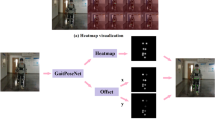Abstract
Lower Limb Exoskeletons (LLEs) are receiving increasing attention for supporting activities of daily living. In such active systems, an intelligent controller may be indispensable. In this paper, we proposed a locomotion intention recognition system based on time series data sets derived from human motion signals. Composed of input data and Deep Learning (DL) algorithms, this framework enables the detection and prediction of users’ movement patterns. This makes it possible to predict the detection of locomotion modes, allowing the LLEs to provide smooth and seamless assistance. The pre-processed eight subjects were used as input to classify four scenes: Standing/Walking on Level Ground (S/WOLG), Up the Stairs (US), Down the Stairs (DS), and Walking on Grass (WOG). The result showed that the ResNet performed optimally compared to four algorithms (CNN, CNN-LSTM, ResNet, and ResNet-Att) with an approximate evaluation indicator of 100%. It is expected that the proposed locomotion intention system will significantly improve the safety and the effectiveness of LLE due to its high accuracy and predictive performance.







Similar content being viewed by others
Data Availability
All data and materials related to the study can be obtained through contacting the author at 213332822@st.usst.edu.cn.
References
Mooney, L. M., Rouse, E. J., & Herr, H. M. (2014). Autonomous exoskeleton reduces metabolic cost of human walking during load carriage. Journal of Neuroengineering and Rehabilitation, 11, 1–11. https://doi.org/10.1186/1743-0003-11-80
Yang, J. T., Sun, T. R., Cheng, L., & Hou, Z. G. (2022). Spatial repetitive impedance learning control for robot-assisted rehabilitation. IEEE/ASME Transactions on Mechatronics, 28, 1280–1290. https://doi.org/10.1109/TMECH.2022.3221931
Mokhtari, M., Taghizadeh, M., & Mazare, M. (2021). Impedance control based on optimal adaptive high order super twisting sliding mode for a 7-DOF lower limb exoskeleton. Meccanica, 56, 535–548. https://doi.org/10.1007/s11012-021-01308-4
Zhong, B. X., Da Silva, R. L., Li, M., Huang, H., & Lobaton, E. (2020). Environmental context prediction for lower limb prostheses with uncertainty quantification. IEEE Transactions on Automation Science and Engineering, 18, 458–470. https://doi.org/10.1109/TASE.2020.2993399
Tucker, M. R., Olivier, J., Pagel, A., Bleuler, H., Bouri, M., Lambercy, O., Millán, J. D. R., Riener, R., Vallery, H., & Gassert, R. (2015). Control strategies for active lower extremity prosthetics and orthotics: a review. Journal of Neuroengineering and Rehabilitation, 12, 1–30. https://doi.org/10.1186/1743-0003-12-1
Young, A. J., & Ferris, D. P. (2016). State of the art and future directions for lower limb robotic exoskeletons. IEEE Transactions on Neural Systems and Rehabilitation Engineering, 25, 171–182. https://doi.org/10.1109/TNSRE.2016.2521160
Mokhtari, M., Taghizadeh, M., & Mazare, M. (2021). Hybrid adaptive robust control based on CPG and ZMP for a lower limb exoskeleton. Robotica, 39, 181–199. https://doi.org/10.1017/S0263574720000260
Hu, B., Rouse, E., & Hargrove, L. (2018). Fusion of bilateral lower-limb neuromechanical signals improves prediction of locomotor activities. Front Robot AI, 5, 78. https://doi.org/10.3389/frobt.2018.00078
Huang, H., Zhang, F., Hargrove, L. J., Dou, Z., Rogers, D. R., & Englehart, K. B. (2011). Continuous locomotion-mode identification for prosthetic legs based on neuromuscular–mechanical fusion. IEEE Transactions on Biomedical Engineering, 58, 2867–2875. https://doi.org/10.1109/TBME.2011.2161671
Laschowski, B., McNally, W., Wong, A., & McPhee, J. (2022). Environment classification for robotic leg prostheses and exoskeletons using deep convolutional neural networks. Frontiers in Neurorobotics, 15, 1–17. https://doi.org/10.3389/fnbot.2021.730965
Kurbis, A. G., Laschowski, B., & Mihailidis, A. (2022). Stair recognition for robotic exoskeleton control using computer vision and deep learning. IEEE International Conference on Rehabilitation Robotics, Rotterdam, Netherlands, 2022, 1–6. https://doi.org/10.1109/ICORR55369.2022.9896501
Kemaev, I., Polykovskiy, D., & Vetrov, D. (2018). Reset: learning recurrent dynamic routing in resnet-like neural networks. The 10th Asian Conference on Machine Learning, Beijing, China, 95, 422–437. https://doi.org/10.48550/arXiv.1811.04380
Wang, M., Wu, X. Y., Liu, D. X., & Wang, C. (2016). A human motion prediction algorithm based on HSMM for SIAT's exoskeleton. The 35th Chinese Control Conference, Chengdu, China, 3891–3896. https://doi.org/10.1109/ChiCC.2016.7553959
Patzer, I., & Asfour, T. (2019). Minimal sensor setup in lower limb exoskeletons for motion classification based on multi-modal sensor data. IEEE International Conference on Intelligent Robots and Systems, Macau, China, 8164–8170. https://doi.org/10.1109/Humanoids43949.2019.9035014
Wu, X. Y., Yuan, Y., Zhang, X. K., Wang, C., Xu, T. T., & Tao, D. C. (2022). Gait phase classification for a lower limb exoskeleton system based on a graph convolutional network model. IEEE Transactions on Industrial Electronics, 69, 4999–5008. https://doi.org/10.1109/tie.2021.3082067
Ren, B., Zhang, Z. Q., Zhang, C., & Chen, S. L. (2022). Motion trajectories prediction of lower limb exoskeleton based on long short-term memory (LSTM) networks. Actuators, 11, 1–15. https://doi.org/10.3390/act11030073
Chen, C. F., Du, Z. J., He, L., Shi, Y. J., Wang, J. Q., & Dong, W. (2021). A novel gait pattern recognition method based on LSTM-CNN for lower limb exoskeleton. Journal of Bionic Engineering, 18, 1059–1072. https://doi.org/10.1007/s42235-021-00083-y
Su, B. B., & Gutierrez-Farewik, E. M. (2020). Gait trajectory and gait phase prediction based on an LSTM network. Sensors, 20, 1–17. https://doi.org/10.3390/s20247127
Li, J. X., Gao, T., Zhang, Z. H., Wu, G. H., Zhang, H., Zheng, J. B., Gao, Y. F., & Wang, Y. (2022). A novel method of pattern recognition based on TLSTM in lower limb exoskeleton in many terrains. The 4th International Conference on Intelligent Control, Measurement and Signal Processing, Hangzhou, China, 733–737. https://doi.org/10.1109/ICMSP55950.2022.9859005
Zhu, M., Guan, X. R., Li, Z., He, L., Wang, Z., & Cai, K. S. (2023). sEMG-based lower limb motion prediction using CNN-LSTM with improved PCA optimization algorithm. Journal of Bionic Engineering, 20, 612–627. https://doi.org/10.1007/s42235-022-00280-3
Lu, Y. Z., Wang, H., Zhou, B., Wei, C. F., & Xu, S. Q. (2022). Continuous and simultaneous estimation of lower limb multi-joint angles from sEMG signals based on stacked convolutional and LSTM models. Expert Systems with Applications, 203, 1–20. https://doi.org/10.1016/j.eswa.2022.117340
Guo, C. Y., Song, Q. Z., & Liu, Y. L. (2022). Research on the application of multi-source information fusion in multiple gait pattern transition recognition. Sensors (Basel), 22, 1–12. https://doi.org/10.3390/s22218551
Zhang, X. D., Li, H. Z., Dong, R. L., Lu, Z. F., & Li, C. X. (2022). Electroencephalogram and surface electromyogram fusion-based precise detection of lower limb voluntary movement using convolution neural network-long short-term memory model. Frontiers in Neuroscience, 16, 1–21. https://doi.org/10.3389/fnins.2022.954387
Zhang, K. E., Wang, J., De Silva, C. W., & Fu, C. L. (2020). Unsupervised cross-subject adaptation for predicting human locomotion intent. IEEE Transactions on Neural Systems and Rehabilitation Engineering, 28, 646–657. https://doi.org/10.1109/TNSRE.2020.2966749
Kuniaki Saito, Watanabe, K., Ushiku, Y., & Harada, T. (2018). Maximum classifier discrepancy for unsupervised domain adaptation. Conference on Computer Vision and Pattern Recognition, Salt Lake City, UT, USA, 3723–3732. https://doi.org/10.1109/CVPR.2018.00392
Zhang, K. E., Xiong, C. H., Zhang, W., Liu, H. Y., Lai, D. Y., Rong, Y. M., & Fu, C. L. (2019). Environmental features recognition for lower limb prostheses toward predictive walking. IEEE Transactions on Neural Systems and Rehabilitation Engineering, 27, 465–476. https://doi.org/10.1109/TNSRE.2019.2895221
Hur, T., Bang, J., Huynh-The, T., Lee, J. W., Kim, J. I., & Lee, S. Y. (2018). Iss2Image: A novel signal-encoding technique for CNN-based human activity recognition. Sensors (Basel), 18, 1–19. https://doi.org/10.3390/s18113910
Khatun, M., Yousuf, M., Ahmed, S., Uddin, M. Z., Alyami, S., Al-Ashhab, S., Akhdar, H., Khan, A., Azad, A. K. M., & Moni, M. A. (2022). Deep CNN-LSTM with self-attention model for human activity recognition using wearable sensor. IEEE Journal of Translational Engineering in Health and Medicine, 10, 1–1. https://doi.org/10.1109/JTEHM.2022.3177710
Zhao, J. F., Mao, X., & Chen, L. J. (2018). Learning deep features to recognise speech emotion using merged deep CNN. IET Signal Processing, 12, 713–721. https://doi.org/10.1049/iet-spr.2017.0320
Hochreiter, S., & Schmidhuber, J. (1997). Long short-term memory. Neural Computation, 9, 1735–1780. https://doi.org/10.1162/neco.1997.9.8.1735
Zhou, X., Wu, X. T., Ding, P., Li, X. G., He, N. H., Zhang, G. Z., & Zhang, X. X. (2019). Research on transformer partial discharge UHF pattern recognition based on CNN-LSTM. Energies, 13, 1–13. https://doi.org/10.3390/en13010061
He, K. M., Zhang, X. Y., Ren, S. Q., & Sun, J., (2016). Deep residual learning for image recognition. IEEE Conference on Computer Vision and Pattern Recognition, Las Vegas, NV, USA, 770–778. https://doi.org/10.1109/CVPR.2016.90
Liu, T. L., Luo, R. H., Xu, L. Q., Feng, D. C., Cao, L., Liu, S. Y., & Guo, J. J. (2022). Spatial channel attention for deep convolutional neural networks. Mathematics, 10, 1–10. https://doi.org/10.3390/math10101750
Woo, S., Park, J., Lee, J.Y., & Kweon, I. S. (2018). CBAM: Convolutional block attention module. The 15th European Conference on Computer Vision, Munich, Germany, 11211, 3–19. https://doi.org/10.1007/978-3-030-01234-2_1
Zhang, H., Wu, C. R., Zhang, Z. Y., Zhu, Y., Lin, H. B., Zhang, Z., Sun, Y., He, T., Mueller, J., & Manmatha, R. (2022). Resnest: Split-attention networks. Conference on Computer Vision and Pattern Recognition, New Orleans, LA, USA, 2736–2746. https://doi.org/10.1109/CVPRW56347.2022.00309
Hu, J., Shen, L., & Sun, G. (2018). Squeeze-and-excitation networks. Conference on Computer Vision and Pattern Recognition, Salt Lake City, UT, 7132–7141. https://doi.org/10.1109/CVPR.2018.00745
Pinto-Fernandez, D., Torricelli, D., del Carmen Sanchez-Villamanan, M., Aller, F., Mombaur, K., Conti, R., Vitiello, N., Moreno, J. C., & Pons, J. L. (2020). Performance evaluation of lower limb exoskeletons: A systematic review. IEEE Transactions on Neural Systems and Rehabilitation Engineering, 28, 1573–1583. https://doi.org/10.1109/TNSRE.2020.2989481
Wan, S. H., Qi, L. Y., Xu, X. L., Tong, C., & Gu, Z. H. (2020). Deep learning models for real-time human activity recognition with smartphones. Mobile Networks and Applications, 25, 743–755. https://doi.org/10.1007/s11036-019-01445-x
Reyes-Ortiz, J. L., Oneto, L., Samà, A., Parra, X., & Anguita, D. (2016). Transition-aware human activity recognition using smartphones. Neurocomputing, 171, 754–767. https://doi.org/10.1016/j.neucom.2015.07.085
Reiss, A., & Stricker, D. (2012). Introducing a new benchmarked dataset for activity monitoring. The 16th International Symposium on Wearable Computers, Newcastle, England, 108–109. https://doi.org/10.1109/ISWC.2012.13
Xia, K., Huang, J. G., & Wang, H. Y. (2020). LSTM-CNN architecture for human activity recognition. IEEE Access, 8, 56855–56866. https://doi.org/10.1109/ACCESS.2020.2982225
Kwapisz, J. R., Weiss, G. M., & Moore, S. A. (2011). Activity recognition using cell phone accelerometers. ACM SigKDD Explorations Newsletter, 12, 74–82. https://doi.org/10.1145/1964897.1964918
Roggen, D., Calatroni, A., Rossi, M., Holleczek, T., Förster, K., Tröster, G., Lukowicz, P., Bannach, D., Pirkl, G., & Ferscha, A. (2010). Collecting complex activity datasets in highly rich networked sensor environments. The 7th International Conference on Networked Sensing Systems, Kassel, Germany, 233–240. https://doi.org/10.1109/INSS.2010.5573462
Zhong, B. X., Silva, R. L. D., Tran, M., Huang, H., & Lobaton, E. (2022). Efficient environmental context prediction for lower limb prostheses. IEEE Transactions on Systems, Man, and Cybernetics: Systems, 52, 3980–3994. https://doi.org/10.1109/TSMC.2021.3084036
Zhang, L. L., Xie, Y. X., Xidao, L., & Zhang, X. (2018). Multi-source heterogeneous data fusion. International Conference on Artificial Intelligence and Big Data, Chengdu, China, 47–51. https://doi.org/10.1109/ICAIBD.2018.8396165
Jiang, M. M., Wu, Q., & Li, X. T. (2022). Multisource heterogeneous data fusion analysis of regional digital construction based on machine learning. Journal of Sensors, 2022, 1–11. https://doi.org/10.1155/2022/8205929
Zhang, F., Yang, J., Sun, C., Guo, X., & Wan, T. T. (2021). Research on multi-source heterogeneous data fusion technology of new energy vehicles under the new four modernizations. Journal of Physics: Conference Series, 1865, 1–15. https://doi.org/10.1088/1742-6596/1865/2/022034
Acknowledgements
The authors gratefully acknowledge the financial support of Shanghai Science and Technology innovation action plan (19DZ2203600).
Author information
Authors and Affiliations
Corresponding author
Ethics declarations
Conflict of interest
The authors report no conflicts of interest. The authors alone are responsible for the content and writing of this article.
Additional information
Publisher's Note
Springer Nature remains neutral with regard to jurisdictional claims in published maps and institutional affiliations.
Rights and permissions
Springer Nature or its licensor (e.g. a society or other partner) holds exclusive rights to this article under a publishing agreement with the author(s) or other rightsholder(s); author self-archiving of the accepted manuscript version of this article is solely governed by the terms of such publishing agreement and applicable law.
About this article
Cite this article
Wang, D., Gu, X. & Yu, H. A Comparison of Four Neural Networks Algorithms on Locomotion Intention Recognition of Lower Limb Exoskeleton Based on Multi-source Information. J Bionic Eng 21, 224–235 (2024). https://doi.org/10.1007/s42235-023-00435-w
Received:
Revised:
Accepted:
Published:
Issue Date:
DOI: https://doi.org/10.1007/s42235-023-00435-w




